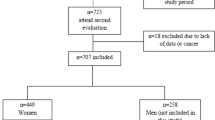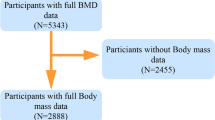Abstract
Objectives
Globally, in an aging population, osteoporosis and fractures are emerging as major public health problems; accessible and affordable recognition, prevention and treatment strategies are needed. Percent body fat is known to be associated with bone mineral density and fractures. This paper uses an innovative, virtually cost-free method to estimate percent body fat from age, height and weight, and assesses its validity by examining the association between percent body fat and fractures among women 39 and older.
Design
An epidemiologic study.
Participants
3940 college alumnae, median age 53.6, participated by responding to a mailed questionnaire covering medical history, behavioral factors, birth date, weight and height.
Statistical methods
T-tests, chi-square and multivariable logistic regression.
Measurements
Percent body fat estimated from age, weight, height and gender.
Results
Associations of fractures with percent body fat are expressed as odds ratios: for osteoporotic (wrist, hip and/or x-ray confirmed vertebral), the adjusted OR = 2.41, 95% CI (1.65, 3.54), P<0.0001; for wrist fractures, the adjusted OR = 2.56, 95% CI (1.65, 3.96), P<0.0001; for x-ray confirmed vertebral fractures the adjusted OR = 4.69, 95% CI (2.05, 10.77), P=0.0003).; and for non-osteoporotic, he adjusted OR= 1.00, 95% CI (0.76 1.32), P=0.999.
Conclusion
The findings are consistent with methods using DXA and/or other technologies that show percent body fat is associated with fractures of the wrist and vertebrae. Identification of risk factors is necessary for the prevention and treatment of osteoporosis and osteoporotic fractures. Estimation of percent body fat from age, height and weight may be a valid, cost-saving, and costeffective alternative tool for screening and assessing risk of osteoporosis in settings where Dual x-ray absorptiometry (DXA) or other radiological techniques are too costly or unavailable.
Similar content being viewed by others
References
U.S. Department of Health and Human Services. Bone Health and Osteoporosis: A Report of the Surgeon General. Rockville MD. U.S. Department of Health and Human Services. Office of the Surgeon General, 2004.
Nelson HD, Morris CD, Kraemer, DF et al, Osteoporosis in postmenopausal women: diagnosis and monitoring. Evidence Report/Technology Assessment No. 28 (Prepared by the Oregon Health & Science University Evidence-based Practice Center under Contract No. 290-97-0018). AHRQ Publication No. 01-E032. Rockville, MD: Agency for Healthcare Research and Quality. Feb, 2002.
Nguyen TV, Sambrook PN, Eisman JA. Bone loss, physical activity, and weight change in elderly women: the Dubbo Osteoporosis Epidemiology Study. J Bone Miner Res. 1998;13:1458–1467.
Hsu YH, Venners SA, Terwedow HA, et al. Relation of body composition, fat mass, and serum lipids to osteoporotic fractures and bone mineral density in Chinese men and women. Am J Clin Nutr. 2006;83:146–154.
DiMonaco M, Vallero F, DiMonaco R, Tapparo R, Cavanna A. Fat mass and skeletal muscle mass in hip-fracture women: a cross-sectional study. Maturitas. 2007;56:404–410.
Zhao Jl, Liu YJ, Liu PY, Hamilton R, Recker RR, Deng HW. Relationship of Obesity with Osteoporosis. J Clin Endocrinol Metab. 2007;92:1640–1646.
Pei L, Tontonoz P. Fat’s loss is bone’s gain. J Clin Invest. 2004;113:805–806.
Janicka A, Wren TAL, Sanchez MM, Dorey F, Kim PS. Fat Mass is not beneficial to bone in adolescents and young adults. J Clin Endocrinol Metab 2007; 92:143–147.
Thorneycroft IH, Lindsay R and Pickar JH. Body composition during treatment with conjugated estrogens with and without medroxyprogesterone acetate: analysis of the women’s Health, Osteoporosis, Progestin, Estrogen (HOPE) trial. Am J Ob/Gyn 2007; 197:137.e11–7.
Elefteriou F, Ahn JD, Takeda S, et al. Leptin regulation of bone resorption by the sympathetic nervous system and CART. Nature. 2005;434(7032):514–520.
Bagger YZ, Rasmussen HB, Alexandersen P, Werge T, Christiansen C, Tanko LB; PERF study group. Links between cardiovascular disease and osteoporosis in postmenopausal women: serum lipids or atherosclerosis per se? Osteoporos Int. 2007;18:505–512.
Tanko LB, Bagger YZ, Nielsen SB, Christiansen C. Does serum cholesterol contribute to vertebral bone loss in postmenopausal women? Bone. 2003;32:8–14.
Xiong DH, Shen H, Zhao LJ, et al. Robust and comprehensive analysis of 20 osteoporosis candidate genes by very high-density single-nucleotide polymorphism screen among 405 white nuclear families identified significant association and genegene interaction. J Bone Miner Res. 2006;21:1678–1695.
Cummings SR, Melton LJ. 2002. Epidemiology and outcomes of osteoporotic fractures. Lancet. 359:1761–1767.
Wyshak G. Hip fracture in elderly women and reproductive history. J Gerontology. 1981;36:424–427.
Wyshak G. Tubal ligation and the risk of vertebral fractures. Osteoporosis International. 2005;16:651–658.
Wyshak G, Frisch RE, Albright TE, Albright NL, Schiff I and Witschi J. Nonalcoholic carbonated beverage consumption and bone fractures. Journal of Orthopaedic Research, 1989;7:91–99.
Wyshak G. Teenaged girls, carbonated beverage consumption, and bone fractures. Arch Pediatr Adolesc Med. 2000;154:610–613.
Zhao LJ, Jiang H., Papasian CJ, et al. Correlation of obesity and osteoporosis: effect of fat mass on the determination of osteoporosis. J Bone Miner Res. 2008;23:17–29.
Afghani A, Abbott AV, Wiswell RA, Jaque SV, Gleckner C, Schroeder ET, Johnson CA. Bone mineral density in Hispanic women: role of aerobic capacity, fat-free mass, and adiposity. Int J Sports Med. 2004 Jul;25(5):384–390.
Afghani A, Barrett-Connor E. Resting energy expenditure: a stronger marker than body weight for bone mineral density in white women but not men? The Rancho Bernardo study. Clin J Sport Med. 2009;19(1):39–45.
Taylor RW, Jones IE, Williams SM, Goulding A. Body fat percentages measured by dual-energy X-ray absorptiometry corresponding to recently recommended body mass index cutoffs for overweight and obesity in children and adolescents aged 3–18 y. Am J Clin Nutr. 2002;76(6):1416–1421.
Goulding A, Taylor RW, Jones IE, McAuley KA, Manning PJ, Williams SM. Overweight and obese children have low bone mass and area for their weight. Int J Obes Relat Metab Disord. 2000;24(5):627–632.
Reid IR. Relationships between fat and bone. Osteoporos Int ( 2008) 19:595–606.
Reid IR, Plank LD, Evans MC. Fat mass is an important determinant of whole body bone density in premenopausal women but not in men. J Clin Endocrinol Metab. 1992;75:779–782.
Rosen CJ and Bouxsein ML. Mechanisms of disease: is osteoporosis the obesity of bone? Nat Clin Pract Rheumatol. 2006;2:35–43.
Rosen, CJ, Klibanski A. Bone, Fat, and Body Composition: Evolving Concepts in the Pathogenesis of Osteoporosis. Review. The American Journal of Medicine, 2009;122:409–414.
Cohn SH, Vartsky D, Yasumura S, et al. Compartmental body composition based on total-body nitrogen, potassium, and calcium. Am J Physiol. 1980;239:E524–E530.
Ellis KJ, Shukla KK, Cohn SH, Pierson RN. A predictor for total body potassium in man based on height, weight, sex and age: applications in metabolic disorders.
Versluis RG, Papapoulos SE, deBock GH, et al. Clinical risk factors as predictors of postmenopausal osteoporosis in general practice. Br J Gen Pract. 2001;51:806–810.
US Preventive Services Task Force. Screening for osteoporosis in postmenopausal women: Recommendations and rationale. Ann Intern Med. 2002;137:526–528.
Saarelainen J, Rikkonen T, Honkanen R, Kroger H, Tuppurainen M, Niskanen L, Jurvelin JS. Is discordance in bone measurements affected by body composition or anthropometry? A comparative study between peripheral and central devices. J Clin Densitom. 2007;10:312–318
Schousboe JT, Ensrud KE, Nyman JA, Melton LJ III, Kane RL. Universal bone densitometry screening combined with alendronate therapy for those diagnosed with osteoporosis is highly cost-effective for elderly women. J Am Geriatr Soc. 2005;53:1697–1704.
Schousboe JT, Taylor BC, Fink HA, et al. Cost-effectiveness of Bone Densitometry Followed by Treatment of Osteoporosis in Older Men. JAMA. 2007;298:629–637.
Leslie WD, Lix LM, Tsang TF, Caetano PA; for the Manitoba Bone Density Program. Single-Site vs Multisite Bone Density Measurement for Fracture Prediction. Arch Intern Med. 2007;167:1641–1647.
Wyshak G and Frisch RE. Breast cancer among former college athletes compared to non-athletes: A fifteen year follow-up. Br J Cancer. 2000, 82:726–730.
Frisch RE, Wyshak G, Albright NL, et al. Lower prevalence of breast cancer and cancer of the reproductive system among former college athletes compared to non athletes. Br J Cancer. 1985;52:885–891.
Colditz GA, Manson JE, Hankinson SE. The Nurses’ Health Study: A 20-year contribution to the understanding of health among women. J. Women’s Health. 1997;6:49–62
SAS (1987) Statistical analysis system. Cary, North Carolina.
Villareal DT, Fontana L, Weiss EP, Racette SB, Steger-May K, Schechtman KB, Klein S, Holloszy JO. Bone mineral density response to caloric restriction-induced weight loss or exercise-induced weight loss: a randomized controlled trial. Arch Intern Med. 2006;166:2502–2510.
Villareal DT, Shah K, Banks MR, Sinacore DR, Klein S. Effect of weight loss and exercise therapy on bone metabolism and mass in obese older adults: a one-year randomized controlled trial. J Clin Endocrinol Metab. 2008;93:2181–2187.
Stewart KJ, Deregis JR, Turner KL, Bacher AC, Sung J, Hees PS, Tayback M, Ouyang P. Fitness, fatness and activity as predictors of bone mineral density in older persons. J Intern Med. 2002;252:381–388.
Margolis KL, Ensrud KE, Schreiner PJ, Tabor HK. Body size and risk for clinical fractures in older women. Study of Osteoporotic Fractures Research Group. Ann Intern Med. 2000;133(2):123–127.
Author information
Authors and Affiliations
Corresponding author
Rights and permissions
About this article
Cite this article
Wyshak, G. Percent body fat, fractures and risk of osteoporosis in women. J Nutr Health Aging 14, 428–432 (2010). https://doi.org/10.1007/s12603-010-0110-1
Received:
Accepted:
Published:
Issue Date:
DOI: https://doi.org/10.1007/s12603-010-0110-1




